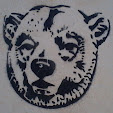. . . eleven sand pits, each a few feet
across, and about 10/15-feet (five meters) apart. They are arranged on a
well-mowed field, like the playing-pitch of some weird French ball-game no-one
else has bothered to learn the rules to! The actual pit is only a foot or two
but the 'spillage' makes them look bigger.
About a 150 feet away (60/70-odd meters?)
is a similar structure or arrangement, this time of ten 'holes' arranged in a
circle, as if someone from Central Planning has marked out the position of a Henge
with sand, for builders, coming later with a load of Blue Granite!
The foreshortening of the photographs
necessitated the rendering of this quick sketch to explain the above 'crop
circle' and a sort of blunt arrow-head! However, scattered around the field
and/or half-duried in the sand are the clues as to the sand's use;
Detonators . . . or their remains! These
pits are for the young engineers to learn one of the tenets of their craft,
namely; blowing stuff up! And further, to learn sequential detonations.
We often hear them at this end of town and
in the past it was a case of thinking "Oh
that's the engineers learning to blow stuff up", but now I count the
explosions, and sure-enough; they often come in ten's or eleven's!
Presumably the ring is used for simple
sequences or synchronised 'blows', while the arrowhead can be used for
alternate detonations, or paired explosions running up to the point, or back
from it.
And using just detonators or small charges,
the whole can be observed safely by students and instructors from the hill on
the other side of the road - you can see in the background of the first shot?
Some of the other paraphernalia associated
with the exercises, which was lying around. To be fair - and given the
frequency with which they can be heard - they do a good job of cleaning the
site between visits, but once I was 'on the case', I quickly found these which
had been blown about the field by wind or explosive-design!
I must stress that with the exception of
the labels; which I posed for the camera, I didn't touch or move anything, it's
just not worth the risk.
Possibly a piece of smoldering hessian from
the sandbags they may place over the charges or maybe a piece of white
phosphorous, if they also learn how to destroy munitions at the same location?
It looks like something which came down from space . . . Thwaaak!
In high summer this is the sort of thing
which starts 'range-fires' and leads to (or contributes to-) those dark, cloudy
backgrounds on otherwise clearly sunny days, you see in old photographs of Barbarossa,
or Kursk; two years later.









No comments:
Post a Comment